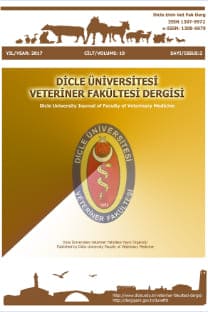Farklı Kedi Irklarının Testislerinde Sitokeratin 8’in İmmunohistokimyasal Lokalizasyonu
Ductus deferens, epididimis, kedi, sitokeratin, testis
Immunohistochemical Localization of Cytokeratin 8 in Testes of Different Cat Breeds
Cat, Cytokeratin, ductus deferens, epididymis, testes,
___
- 1. Cheville JC, Rao S, Iczkowski KA, Lohse CM, V. Pankratz VS. (2000). Cytokeratin Expression in Seminoma of The Human Testis. Am J Clin Pathol. 113:583-588.
- 2. Tamai Y, Ishikawa T, Bösl MR et al. (2000). Cytokeratins 8 and 19 In The Mouse Placental Development. The Journal of Cell Biology. 151(3): 563-572
- 3. Yılmaz S. (2021). A Novel Epithelial and Fibroblastic Cell Isolation and Purification Method Using Primary Culture of Bovine Tongue Tissue. Kafkas Univ Vet Fak Derg. 27(6): 675-680.
- 4. Wagner MS, Wajner SM, Maia AL. (2008). The Role of Thyroid Hormone In Testicular Development and Function. J Endocrinol. 199(3): 351-365.
- 5. Mruk DD, Cheng CY. (2002). Sertoli-Sertoli and Sertoli-Germ Cell Interactions and Their Significance in Germ Cell Movement in the Seminiferous Epithelium during Spermatogenesis. Endocrine Reviews. 25(5):747-806.
- 6. Topaloğlu U, Akbalık ME, Sağsöz H. (2021). Immunolocalization of Some HOX Proteins In Immature and Mature Feline Testes. Anatomia, Histologia, Embryologia. 50: 726-735.
- 7. Çelenk F, Saruhan BG, Akbalık ME, Topaloğlu, Aydın N, Bayram B. (2021). Yetişkin Boğa ve Koçların Testis ve Epididimal Kanal Ünitesindeki Vimentinin İmmünohistokimyasal Dağılımı. Dicle Üniv Vet Fak Derg. 14(2):83-88.
- 8. Beyaz F, Bayram GK, Alan E. (2009). Vimentin, Sitokeratin, α-SMA ve Desmin’in Yeni Zellanda Tavşanı Testis ve Epididimisindeki İmmunohistokimyasal Ekspresyonu. Erciyes Üniv Vet Fak Derg. 6(2): 111-119.
- 9. Miguel MP, Bethencourt FR, Arenas MI, Fraile B, Paniagua R. (1997). Intermediate Filaments In The Sertoli Cells of The Ageing Human Testis. Virchows Arch. 431:131-138.
- 10. Santiago J, Silva JV, Alves MG, Oliveira PF, Fardilha M. (2019). Testicular Aging: An Overview of Ultrastructural, Cellular, and Molecular Alterations. J Gerontol A Biol Sci Med Sci. 74 (6): 860-871.
- 11. Amlani S, Vogl AW. (1988). Changes in the Distribution of Microtubules and Intermediate Filaments in Mammalian Sertoli Cells During Spermatogenesis. The Anatomical Record. 220:143-160.
- 12. Steger K, Schimmel M, Wrobel KH. (1994). Immunohistochemical Demonstration of Cytoskelatal Proteins In Seminiferous Tubules of Adult Rams and Bulls. Arch Histol Cytol. 57(1): 17-28.
- 13. Wakui S, Furusato M, Shinichiro U, Kano Y. (1994). Coexpression of Different Cytokeratins, Vimentin and Desmin In The Rete Testis and Epididymis nn the Dog. J Anat. 184: 147-151.
- 14. Akbalik ME, Sagsoz H, Erdogan S. (2015). Osteopontin Epression in the Intestine of Chukar Partridge (Alectoris chukar, Gray, 1830). Animal Biology. 65(3-4): 287-298.
- 15. Dunleavy JEM, O’Bryan MK, Stanton PG, O’Donnell L. (2019). The Cytoskeleton in Spermatogenesis. Reproduction. 157 (2): R53-R72.
- 16. Stosiek P, Kasper M, Karsten U. (1990). Expression of Cytokeratins 8 and 18 in Human Sertoli Cells of Immature and Atrophic Seminiferous Tubules. Differentiation. 43(1): 66-70.
- 17. Lehtonen E. (1985). A Monoclonal Antibody Against Mouse Oocyte Cytoskeleton Recognizing Cytokeratin-Type Filaments. J Embryo1 Exp Morpho. l90:197-209.
- 18. Park YJ, Kim JH, Kim HY et al. (2020). The Expression and Localization of V-ATPase and Cytokeratin 5 during Postnatal Development of The Pig Epididymis. Asian-Australas J Anim Sci Vol. 33(7) :1077-1086.
- 19. Pecile A, Groppetti D, Pizzi G et al. (2021). Immunohistochemical Insights into a Hidden Pathology: Canine cryptorchidism. Theriogenology. 176: 43-53.
- 20. Rogatsch H, Jezek D, Mikuz AHG, Feichtinger H. (1996). Expression of Vimentin, Cytokeratin, and Desmin in Sertoli Cells of Human Fetal, Cryptorchid, and Tumour-Adjacent Testicular Tissue. Virchows Arch. 427:497-502.
- 21. Dinges HP, Zatloukal K, Schmid C, Mair S, Wirnsberger G. (1991). Co-Expression of Cytokeratin and Vimentin Filaments İn Rete Testis and Epididymis. Virchows Archiv A Pathol Anat. 418:119-127.
- 22. Kasper M, Stosiek P. (1989). Immunohistochemical Investigation of Different Cytokeratins and Vimentin İn The Human Epididymis from The Fetal Period up to Adulthood. Cell Tissue Res. 257:661-664.
- 23. Regadera J, España G, Roias MA, Recio JA, Nistal M, Suárez-Quian CA. (1997). Morphometric and Immunocytochemical Study of the Fetal, Infant, and Adult Human Vas Deferens. Journal of Andrology. 18(6): 623-636.
- ISSN: 1307-9972
- Yayın Aralığı: Yılda 2 Sayı
- Başlangıç: 2008
- Yayıncı: Dicle Üniversitesi Veteriner Fakültesi
Siirt İli Buzağılarında Toxocara vitulorum Prevalansı Üzerine Bir Çalışma
Adnan AYAN, Burçak ASLAN ÇELİK, Özgür Yaşar ÇELİK, Özge OKTAY AYAN
Parvoviral Enteritise Bağlı Septik veya Septik Olmayan Köpeklerde Hematolojik Durum
Blastocystis sp.'nin İnsanlara Bulaşında İnsanlarla Yakın İlişkili Hayvanların Rolü
Fatih ÇAKIR, Muttalip CİCEK, Hasan İÇEN, İbrahim YILDIRIM, Akın KOÇHAN
Blastocystis sp.'nin İnsanlara Bulaşında İnsanlarla Yakın İlişkili Hayvanların Rolü
Fatih ÇAKIR, Akın KOÇHAN, Muttalip ÇİÇEK, Hasan İÇEN, İbrahim Halil YILDIRIM
Propolis ve Ruminantlarda Alternatif Yem Katkı Maddesi Olarak Kullanımı
Gülşah SARAL, Firdevs BİNLİ, Serhan Serhat AY
Farklı Kedi Irklarının Testislerinde Sitokeratin 8’in İmmunohistokimyasal Lokalizasyonu
Zelal KARAKOÇ, Uğur TOPALOĞLU, Mehmet Erdem AKBALIK, Berna GÜNEY SARUHAN, Nurşin AYDIN
Kırıkkale İlinde Kesilen Simental Irkı Sığırların Bazı Kesim ve Karkas Özellikleri
